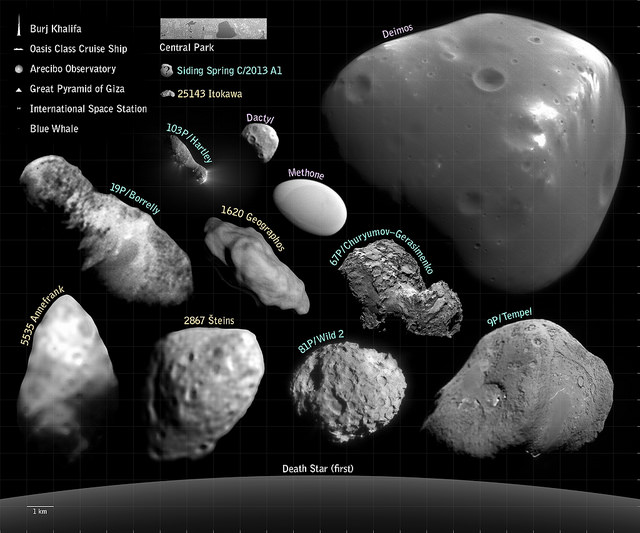We’ve seen a bunch of pictures comparing Comet 67P/Churyumov–Gerasimenko with all kinds of cities and objects on Earth, but it’s hard to put everything in perspective. Just how big is this thing? How big is it compared to other asteroids and comets we’ve imaged? What about more familiar objects, like the Burj Khalifa and Central Park?
How big is 67P/Churyumov–Gerasimenko compared to the Death Star?!?
Fortunately, our good friend Judy Schmidt @SpaceGeck took it upon herself to clear this all up. She created this wonderful infographic that shows 67/P surrounded by a bunch of other objects in the Solar System with a similar size. There’s Siding Spring, the Mars moon Deimos, 19P/Borrelly, 103P/Hartley, and others.
And then they’re compared to the Burj Khalifa, a blue whale, the Great Pyramid of Giza, and much more.
But most importantly, at the bottom of the image, you can see the slight curvature of a fully operational Death Star. Yeah… those things are pretty big.
Anyway, I highly recommend you check out Judy’s post about the illustration over on Flickr and read her behind the scenes commentary.
And while you’re at it, check out her previous illustration of 100 planetary nebulae in a single image.
Source: Judy Schmidt’s Flickr Page


Notice a paucity of responses?
It isn’t much wonder.
– Rosetta, – Comet 67P, – the Eiffel Tower – etc.
These are objects we can measure.
>Quote: “How big is 67P/Churyumov–Gerasimenko compared to the Death Star?!?<
What Death Star? Where is it?
If you're running a facts-based blog then please drop the pathetic childishness and get with it while you still have followers.
Would have preferred seeing this without the Death Star comparison. Adding the Death Star gives the sense of making the image less scientific; sorta like dumbing it down.
Now that you have our attention, please sir more. The Death Star please. Who gave this rock that name and how or does it relate to Earth? wc